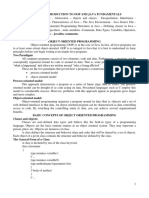0% found this document useful (0 votes)
111 views9 pagesChapter 1 (Intro To Object Oriented Prog.)
The document introduces object-oriented programming concepts in Java, including defining a class as a template for objects with attributes and behaviors, and the key characteristics of abstraction, encapsulation, inheritance, and polymorphism. Examples are provided to illustrate classes and objects as well as each of the OOP characteristics. The chapter also discusses the advantages of using an object-oriented approach.
Uploaded by
Adam Sa'alpataCopyright
© © All Rights Reserved
We take content rights seriously. If you suspect this is your content, claim it here.
Available Formats
Download as PDF, TXT or read online on Scribd
0% found this document useful (0 votes)
111 views9 pagesChapter 1 (Intro To Object Oriented Prog.)
The document introduces object-oriented programming concepts in Java, including defining a class as a template for objects with attributes and behaviors, and the key characteristics of abstraction, encapsulation, inheritance, and polymorphism. Examples are provided to illustrate classes and objects as well as each of the OOP characteristics. The chapter also discusses the advantages of using an object-oriented approach.
Uploaded by
Adam Sa'alpataCopyright
© © All Rights Reserved
We take content rights seriously. If you suspect this is your content, claim it here.
Available Formats
Download as PDF, TXT or read online on Scribd
/ 9

















































































